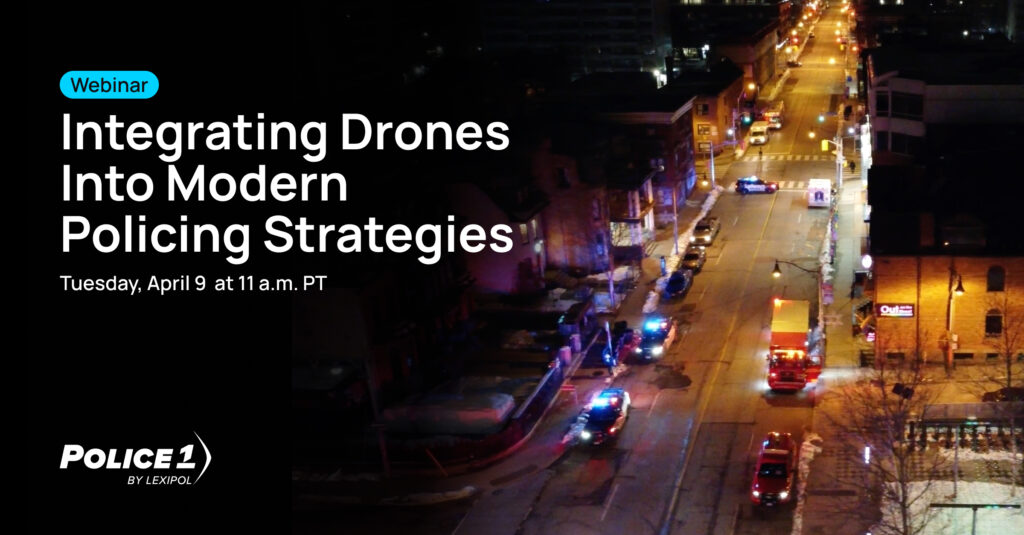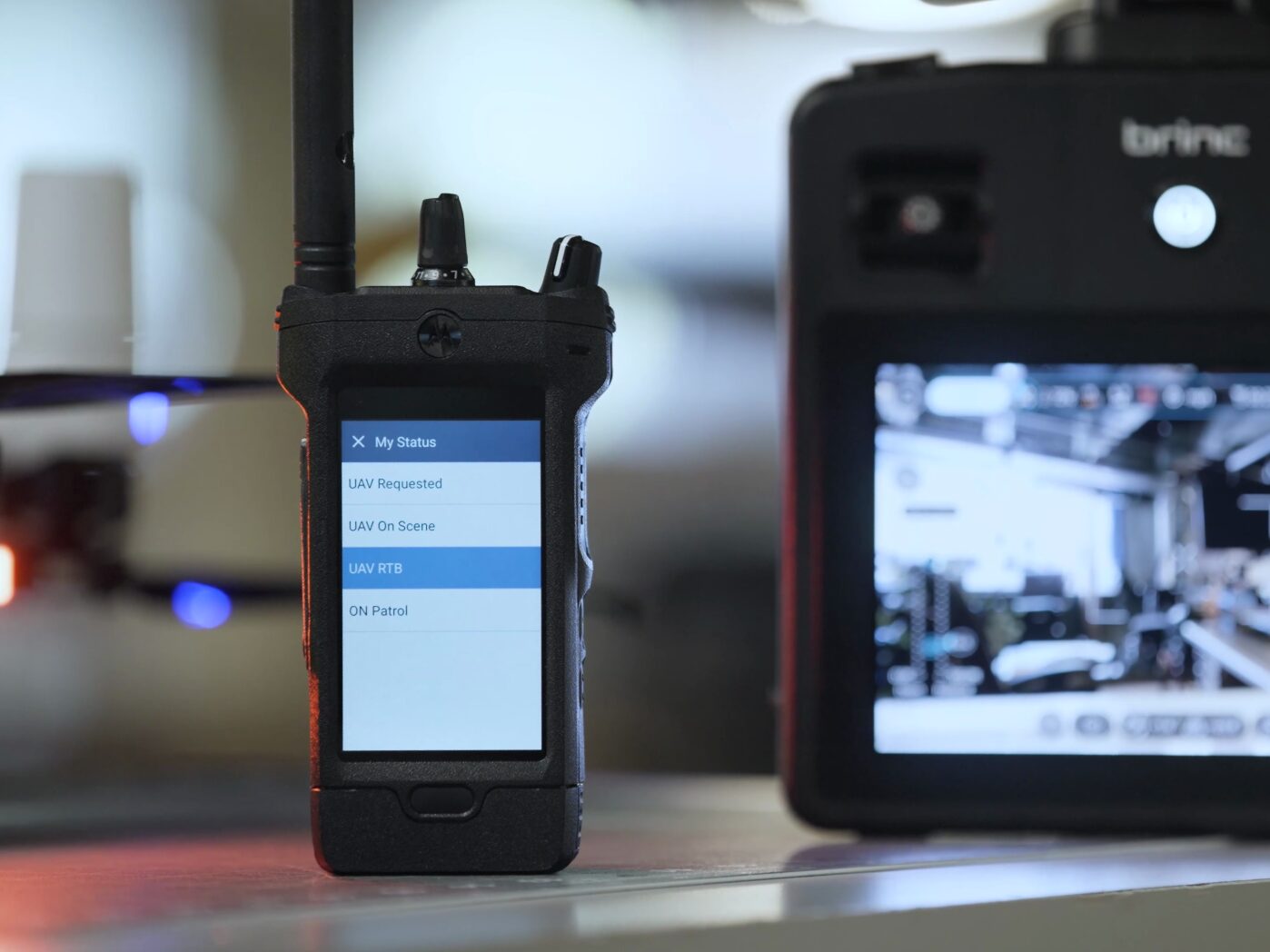What to Consider When Scaling a Drone Program

Launching or scaling a drone program demands careful consideration and planning. With drones playing an increasingly vital role in public safety and emergency response, agencies must carefully evaluate numerous factors to ensure effective implementation.
These factors range from addressing privacy concerns and ensuring regulatory compliance to selecting the most suitable equipment among various options. In this blog, we explore critical considerations and recommendations for agencies looking to establish or expand their drone programs.
Table of Contents
- Privacy Concerns and Transparency
- Regulations and Policy
- Budgeting and ROI
- Cybersecurity Concerns
- Integration with Public Safety Operations
Privacy Concerns and Transparency
In the development of a drone program, early community engagement is essential. This helps address pressing concerns about public trust, civil liberties, and the public’s right to privacy.
Proactively reaching out to community organizations, jurisdictional leadership, the media, and other relevant stakeholders is crucial. It helps in formulating policies and operational guidelines with full transparency. This requires maintaining a consistent and open communication channel. The aim is to address any evolving concerns associated with city-wide drone implementation and operations.
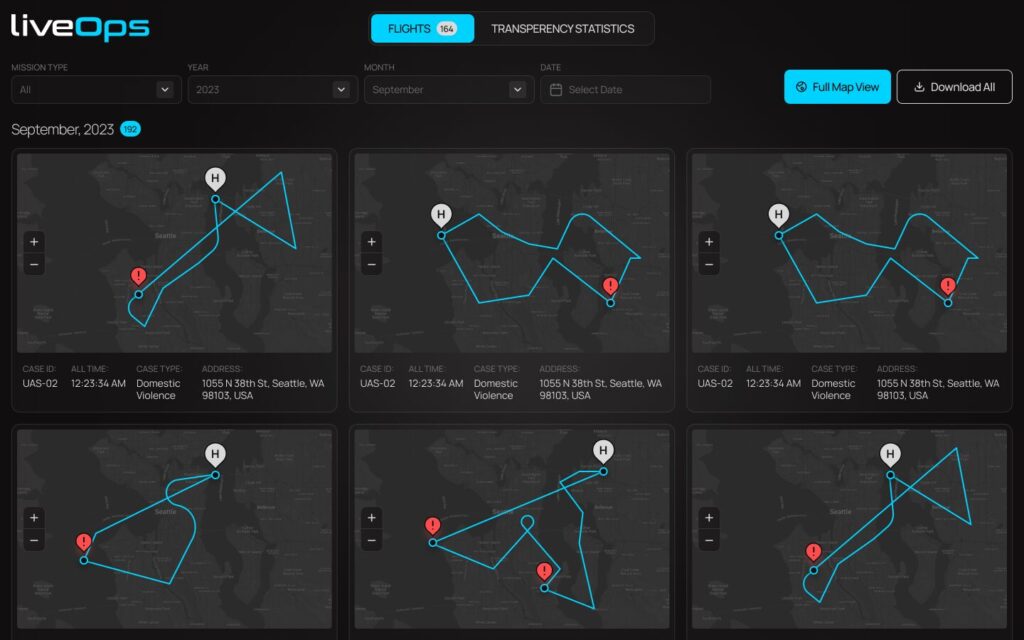
Maintaining a public record of daily flights is crucial for agencies. This record should include details such as the purpose, location, flight telemetry, date, and time of each flight.
This measure enables community members to easily access information about why a public safety drone is in the area by referring to the agency’s website. Furthermore, it’s advisable to have an analytics dashboard. This dashboard can track the frequency of drone deployments during emergencies and their role in arrests.
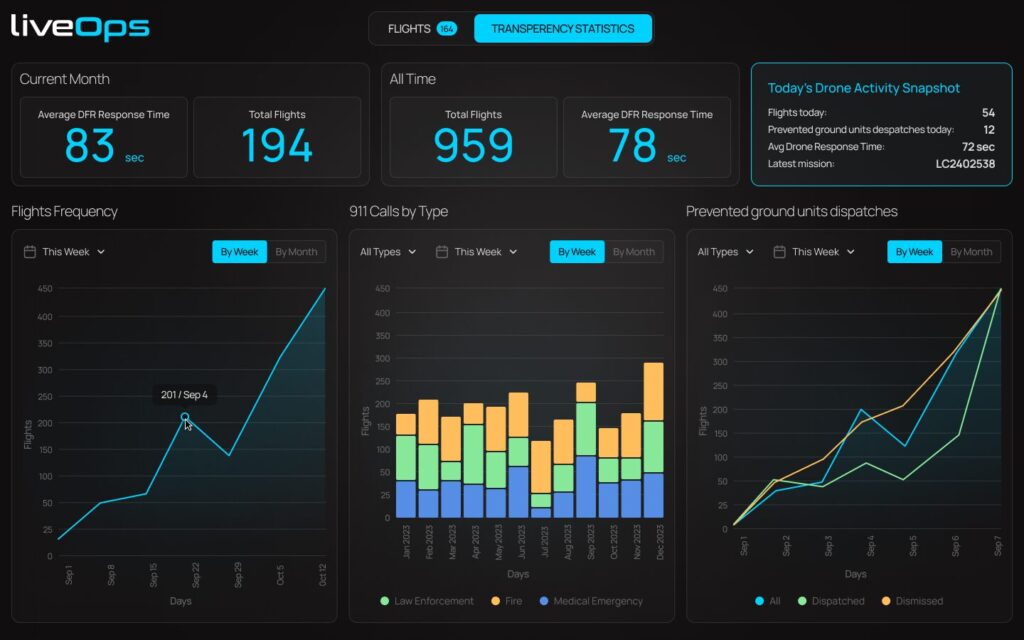
Early Example – CVPD’s Transparency Dashboard
In the Chula Vista Police Department’s (CVPD) drone as first responder (DFR) program, which utilizes drones to promptly respond to emergencies upon receiving a call for service, a notable contributor to the program’s success and its city-wide adoption is their transparency portal.
The program’s mission is to provide airborne support to police operations in a safe, responsible, and transparent manner, aiming to preserve the peace, reduce response times, and enhance the quality of life in Chula Vista. Find out more about why agencies are implementing DFR programs.
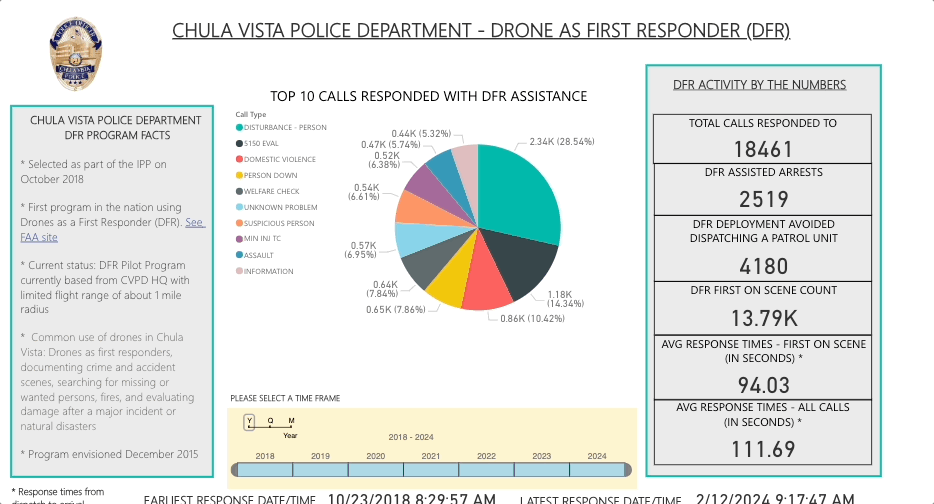
Regulations and Policy
Drone operations are governed by FAA regulations and may also be influenced by state and local ordinances. As such, agencies contemplating the adoption of drones (UAVs) must possess a comprehensive understanding of FAA waivers and the requisite legal operational standards.
To legally pilot drones, individuals can acquire certification through the FAA’s Aeronautical Knowledge Test. Upon successful completion, each participant is awarded a Remote Pilot Certificate (FAA Part 107), a foundational step for both trialing drones and initiating a program.
It is worth noting, however, that this certification comes with specific flight limitations and restrictions to include flights within visual line of sight (VLOS), operations at night, operations of a single aircraft, and operations over people and vehicles.
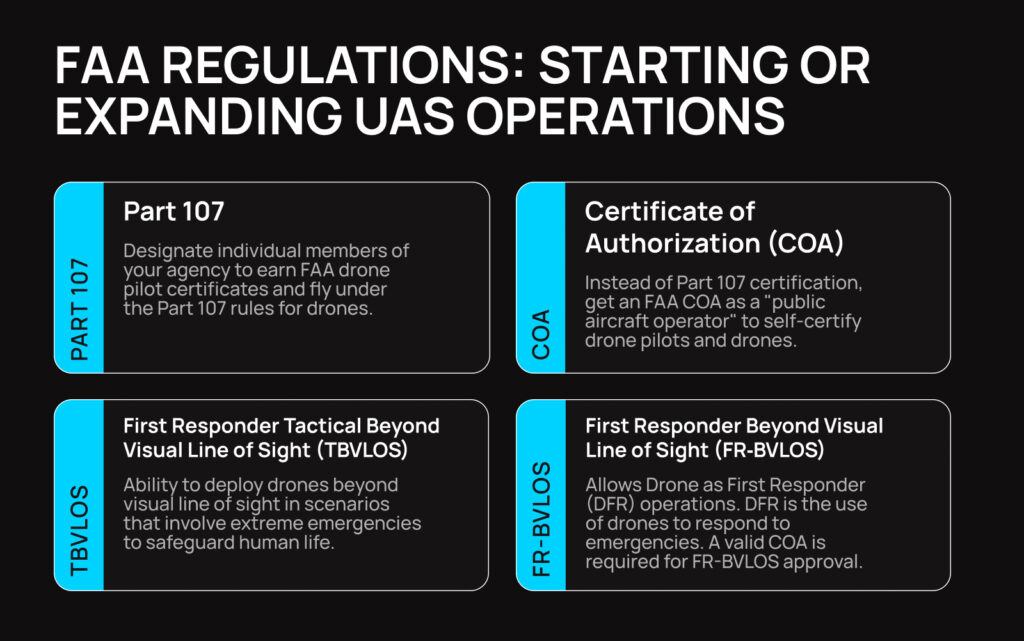
For a more flexible operational scope, agencies can pursue the FAA Part 91 Certificate of Authorization (COA). This certification empowers public safety drone programs to set their own standards and implement the necessary evaluations for members to attain drone pilot status. Although obtaining a Part 91 COA is a more extensive process, it affords pilots a broader range of flight permissions.
TBVLOS, or Tactical Beyond Visual Line of Sight, waivers enable first responders to operate unmanned aircraft systems (UAS) in critical emergencies, such as fires or search missions, where human life is at risk. The FAA grants these waivers under specific conditions. These conditions include the requirement for a valid Part 91 COA, limitations on altitude and proximity to obstacles, and the necessity to revert to visual line of sight operations when practical.
FR-BVLOS, or First Responder Beyond Visual Line of Sight, waivers enable DFR operations, marking a significant advancement in public safety drone programs. DFR involves drones swiftly responding to emergencies upon receiving a call for service, delivering vital information to enhance response efforts. To be approved by the FAA, an agency must possess a valid COA, adhere to altitude and obstacle proximity restrictions, and revert to visual line of sight operations when possible.
Budgeting and ROI
Establishing a drone program demands foresight, patience, and concerted effort. Crafting a long-term strategy to sustain your agency’s drone program is pivotal for enduring success. In exploring the benefits of UAS, a shift towards data-driven analysis offers a compelling perspective on return on investment (ROI).
Collaborating with UAS providers to customize programs tailored to public safety needs enables the quantification of efficiencies, reduction in manpower, and optimized resource allocation.
UAS operations have the potential to minimize overtime expenses while expanding law enforcement capabilities at a fraction of traditional costs.
Ultimately, integrating UAS into public safety isn’t just about adopting technology—it’s about maximizing ROI through intelligent decision-making and resource management, while enhancing public safety.
Cybersecurity Concerns
As drone programs expand, the amount of information collected and stored by drones and associated software will increase significantly, encompassing various aspects of our towns, cities, and other regions.
This necessitates a careful approach in vendor selection and data storage protocols to address cybersecurity risks effectively. These risks can be divided into three main areas: data in transit, data at rest, and data governance.
Data in transit involves the information transmitted between devices, such as between the drone and its operator. It’s crucial that all data transmitted is encrypted end-to-end to prevent unauthorized interception and access.
AES-256 encryption is essential for secure drone-to-operator communication, providing robust protection with its 256-bit key, ensuring confidentiality and integrity during data transmission.
Data at rest pertains to the data stored within a device. Measures must be implemented to ensure that access to storage mediums like SD cards is safeguarded through password protection and physical security measures.
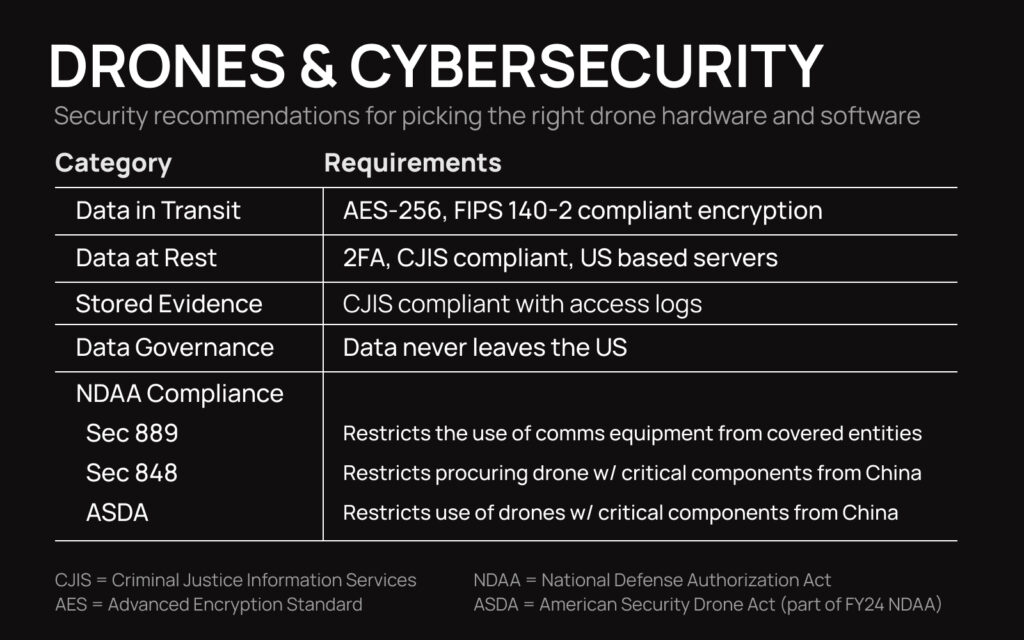
Data governance is essential, with trust in chosen vendors paramount for agencies. It’s crucial to ensure data remains within the country and that software is Criminal Justice Information Services (CJIS) compliant, adhering to FBI security standards for storing, transmitting, and accessing criminal justice information.
Maintaining software development free from influence by foreign entities is imperative to mitigate data security risks.
Additionally, NDAA compliance and supply chain security play a vital role in bolstering supply chain security, ensuring crucial drone components are not sourced from covered foreign countries or companies.
Federal policy restricts taxpayer funds for purchasing drones from Chinese-based companies and encourages the adoption of domestically produced UAS. This stance is echoed by federal departments, including the Departments of Interior, Justice, and Homeland Security, with many states implementing their own regulations on untrustworthy drones for state or local agencies.
Integration with Public Safety Operations
Drones should not be viewed merely as standalone equipment but as integral components of a comprehensive UAS program. Their applications, including outdoor overwatch, indoor tactical response, mapping, and DFR operations, have already proven invaluable across various jurisdictions.
A thorough evaluation of agency-specific needs is essential, followed by seamless integration of UAS operations into established law enforcement, firefighting, and EMS protocols.
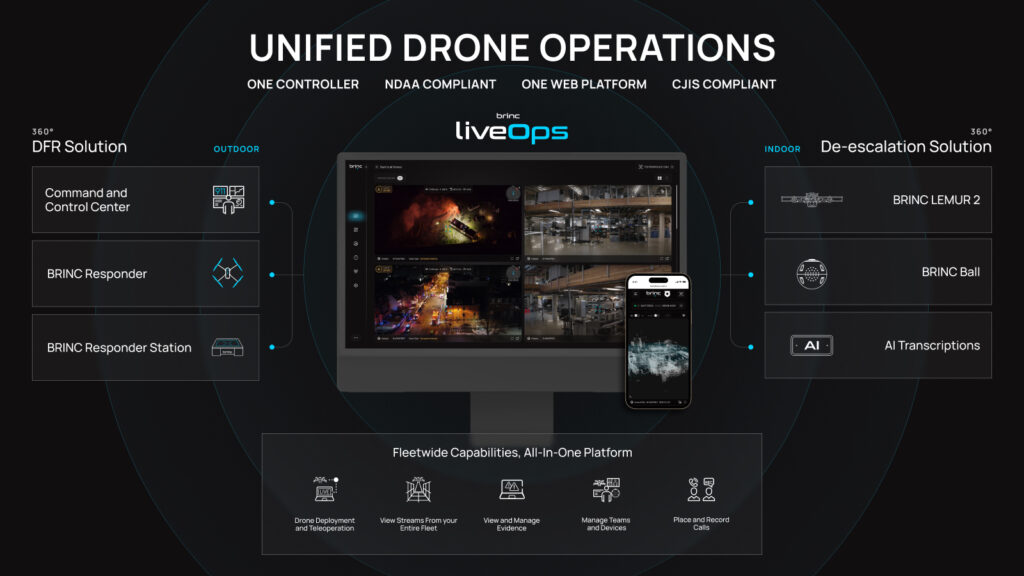
An essential evolution involves embedding drone functionality into core emergency response strategies. By thoroughly integrating drones into routine operations, agencies can develop a deeper organizational understanding of their capabilities. Such integration efforts should involve diverse stakeholders, ensuring a robust outcome with widespread internal support.
Having a platform to manage, organize, and operate a drone program is paramount to success. Integrating with BRINC LiveOps, a cloud-based platform streamlining drone program operations, offers a comprehensive set of features to enhance UAS operations seamlessly.
From viewing live streams and 2D floor plan data to facilitating communication and teleoperation, LiveOps provides the tools needed to manage fleets, track operations, and maintain transparency with the community in real-time. Moreover, LiveOps is robust enough to integrate into existing agency software solutions for a seamless integration, including CAD and 911 call systems.
Conclusion
In summary, launching or expanding a drone program requires careful consideration of transparency, regulations, budgeting, and integration. Prioritizing transparency, community engagement, and cybersecurity is essential for long term success. Platforms like BRINC LiveOps aid management and integration, ensuring efficiency and innovation in public safety efforts.
If your agency would like the BRINC team to help review your current operations and use our expertise to help aid your program, you can schedule a drone program review.
